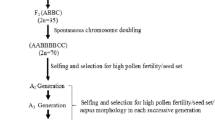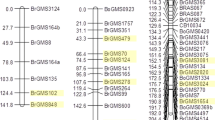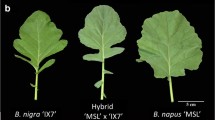Abstract
Brassica napus plants, artificially synthesized through somatic hybridization of B. oleracea and B. campestris protoplasts, were analyzed by oligonucleotide fingerprinting. While the fingerprint patterns of the different hybrid plants looked very much alike, they did not simply represent a combination of the parental patterns. Instead, the absence of parental bands as well as the presence of new bands suggest that elimination and/or rearrangements occurred during or after the fusion of the two genomes. The fingerprints of individual F1 progeny plants of selfed hybrids did not detect major changes. Thus, once formed, the artificially resynthesized amphidiploid B. napus genome appears to be stable. Taken together, our experiments demonstrate the usefulness of oligonucleotide fingerprinting for the characterization of artificial hybrids in the genus Brassica.
Similar content being viewed by others
References
Baird, E., S. Cooper-Bland, R. Waugh, M. DeMaine & W. Powell, 1992. Molecular characterisation of inter- and intraspecific somatic hybrids of potato using randomly amplified polymorphic DNA (RAPD) markers. Mol. Gen. Genet. 233: 469–475.
Bennett, R.I. & A.G. Smith, 1991. The complete nucleotide sequence of the intergenic spacer region of an rDNA operon from Brassica oleracea and its comparison with other crucifers. Plant. Mol. Biol. 16: 1095–1098.
Chen, B.Y., W.K. Heneen & R. Jönsson, 1988. Resynthesis of Brassica napus L. through interspecific hybridization between B. alboglabra Bailey and B. campestris L. with special emphasis on seed colour. Plant Breeding 101: 52–59.
Chen, B.Y., W.K. Heneen & V. Simonsen, 1989. Comparative and genetic studies of isozymes in resynthesized and cultivated Brassica napus L., B. campestris L. and B. alboglabra Bailey. Theor. Appl. Genet. 77: 673–679.
Epplen, J.T., H. Ammer, C. Epplen, C. Kammerbauer, R. Mitreiter, L. Roewer, W. Schwaiger, V. Steimle, H. Zischler, E. Albert, A. Andreas, B. Beyermann, W. Meyer, J. Buitkamp, I. Nanda, M. Schmid, P. Nürnberg, S.D.J. Pena, H. Pöche, W. Sprecher, M. Schartl, K. Weising & A. Yassouridis, 1991. Oligonucleotide fingerprinting using simple repeat motifs: a convenient, ubiquitously applicable method to detect hypervariability for multiple purposes. In: T. Burke, G. Dolf, A.J. Jeffreys & R. Wolff (Eds.). DNA Fingerprinting: Approaches and Applications, pp. 50–69. Birkhäuser, Basel.
Glimelius, K., J. Fahleson, M. Landgren, C. Sjödin & E. Sundberg, 1990. Improvements of Brassica crops by transfer of genes from alien species via somatic hybridization. In: H.J.J. Nijkamp, L.H.W. van der Plas & J. van Aartrijk J (Eds.). Progress in Plant Cellular and Molecular Biology, pp. 299–304. Kluwer, Dordrecht.
Halldén, C., T. Bryngelsson, T. Säll & M. Gustafsson, 1987. Distribution and evolution of a tandemly repeated DNA sequence in the family Brassicaceae. J. Mol. Evol. 25: 318–323.
Hu, J. & C.F. Quiros, 1991. Identification of Broccoli and cauliflower with RAPD markers. Plant Cell. Rep. 10: 505–511.
Itoh, K., M. Iwabuchi & K. Shimamoto, 1991. In situ hybridization with species-specific DNA probes gives evidence for asymmetric nature of Brassica hybrids obtained by X-ray fusion. Theor. Appl. Genet. 81: 356–362.
Lelivelt, C.L.C. & F.A. Krens, 1992. Transfer of resistance to the beet cyst nematode (Heterodera schachtii Schm.) into the Brassica napus L. gene pool through intergeneric somatic hybridization with Raphanus sativus L. Theor. Appl. Genet. 83: 887–894.
Mündges, H., E. Diederichsen & W. Köhler, 1989. Comparison of isozyme patterns in resynthesised amphihaploid rapeseed (Brassica napus) and their parental species Brassica campestris and Brassica oleracea. Plant Breeding 103: 258–261.
Nürnberg, P. & J.T. Epplen, 1989. Hidden partials—a cautionary note. Fingerprint News 1: 11–12.
Olsson, G. & S. Ellerström, 1980. Polyploidy Breeding in Europe. In: S. Tsunda, K. Hinata & C. Goméz-Campo C. (Eds.). Brassica Crops and Wild Allies. Biology and Breeding, pp. 167–190. Jpn. Sci. Soc. Press, Tokyo.
Poulsen, G.B., G. Kahl & K. Weising, 1993. Abundance and polymorphism of simple repetitive DNA sequences in Brassica napus L. Theor. Appl. Genet. 85: 994–1000.
Quiros, C.F., J. Hu, P. This, A.M. Chevre & M. Delseny, 1991. Development and chromosomal localization of genome-specific markers by polymerase chain reaction in Brassica. Theor. Appl. Genet. 82: 627–632.
Rosén, B., C. Halldén & W.K. Heneen, 1988. Diploid Brassica napus somatic hybrids: Characterization of nuclear and organellar DNA. Theor. Appl. Genet. 76: 197–203.
Sacristan, M.D., M. Gerdemann-Knörck & O. Schieder, 1989. Incorporation of hygromycin resistance in Brassica nigra and its transfer through asymmetric protoplast fusion. Theor. Appl. Genet. 78: 194–200.
Schenck, H.R. & G. Röbbelen, 1982. Somatic hybrids by fusion of protoplasts from Brassica oleracea and B. campestris. Z. Pflanzenzüchtg. 89: 278–288.
Sundberg, E. & K. Glimelius, 1986. A method for production of interspecific hybrids within Brassicaeae via somatic hybridization using resynthesis of Brassica napus as a model. Plant Sci. 43: 155–162.
Sundberg, E. & K. Glimelius, 1991a. Production of cybrid plants within Brassicaeae by fusing protoplasts and plasmolytically induced cytoplasts. Plant Sci. 79: 205–216.
Sundberg, E. & K. Glimelius, 1991b. Effects of parental ploidy level and genetic divergence on chromosome elimination and chloroplast segregation in somatic hybrids within Brassicacea. Theor. Appl. Genet. 83: 81–88.
Terada, R., Y. Yamashita, S. Nishibayashi & K. Shimamoto, 1987. Somatic hybrids between Brassica oleracea and B. campestris: selection by the use of iodoacetamide inactivation and regeneration ability. Theor. Appl. Genet. 73: 379–384.
U. N., 1935. Genome analysis in Brassica with special reference to the experimental formation of B. napus and peculiar mode of fertilization. Jap. J. Bot. 7: 389–452.
Weising, K., B. Beyermann, J. Ramser & G. Kahl, 1991. Plant DNA fingerprinting with radioative and digoxigenated oligonucleotide probes complementary to simple repetitive sequences. Electrophoresis 12: 159–169.
Xu, Y.-S., M.S. Clark & E. Pehu, 1993. Use of RAPD markers to screen somatic hybrids between Solanum tuberosum and S. brevidens. Plant Cell. Rep. 12: 107–109.
Yamashita, Y., R. Terada, S. Nishibayashi & K. Shimamoto, 1989. Asymmetric somatic hybrids of Brassica: partial transfer of B. campestris genome into B. oleracea by cell fusion. Theor. Appl. Genet. 77: 189–194.
Yarrow, S.A., L.A. Burnett, R.P. Wildeman, R.P. Kemble & R.J. Kemble, 1990. The transfer of Polima cytoplasmic male sterility from oilseed rape (Brassica napus) to broccoli (B. oleracea) by protoplast fusion. Plant Cell. Rep. 9, 185–188.
Author information
Authors and Affiliations
Rights and permissions
About this article
Cite this article
Poulsen, G.B., Kahl, G. & Weising, K. Oligonucleotide fingerprinting of resynthesized Brassica napus . Euphytica 70, 53–59 (1993). https://doi.org/10.1007/BF00029640
Received:
Accepted:
Issue Date:
DOI: https://doi.org/10.1007/BF00029640




